While some tattooers set up cozy studios in the concrete jungles of big cities, Elizabeth Collinson chooses freedom — true freedom, without walls or borders. Her studio floats above coral reefs, sails through the Caribbean Sea, and welcomes guests aboard a large sailing catamaran transformed into a self-sufficient creative island. Behind her — over two decades in the tattoo industry, adventures across South America, award-winning shows, and a deep connection to the sea passed down through generations of seafarers. Ahead — wind, open ocean, and new tattoo stories crafted at the intersection of art, travel, and absolute freedom.
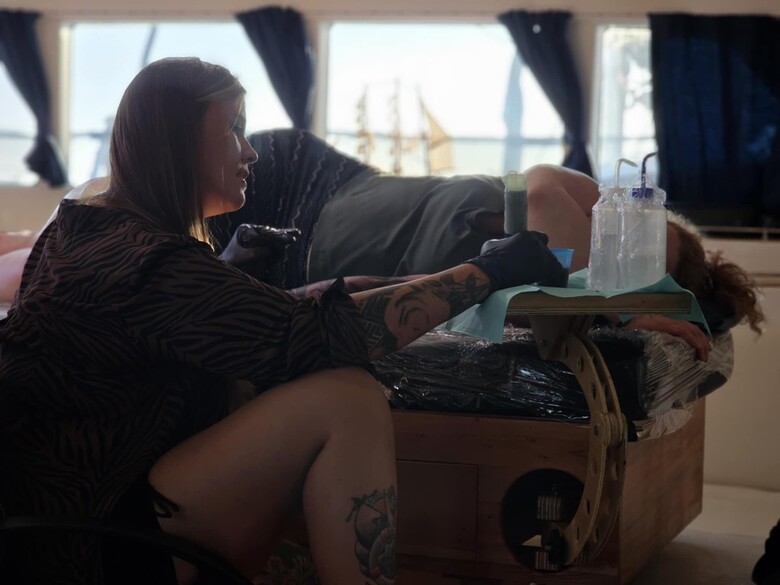
—Hi,Liz! Can you tell us how you started your career in the tattoo industry?
— If you told me I was going to be a pirate sailing the Caribbean when I grew up, I would have laughed at you.
It’s a bit of a long and complicated journey. I did my first tattoo at a very young age. I was 14 when I hacked together a tattoo machine from parts I’d pulled from my old Walkman. I was 10 when my mom bought me a bunch of late '90s tattoo catalogues—Huck Spaulding. There were some very useful machine diagrams in one of these books. I tattooed a buddy of mine at the time—it was supposed to be a tribal panther, but unfortunately, it came out looking like a mosquito. I became obsessed with the flash and dragged these books all over my school, drawing on classmates. I got in some trouble for my attempt at tattooing, so it got shut down pretty quickly after that. But art was always encouraged throughout my childhood.
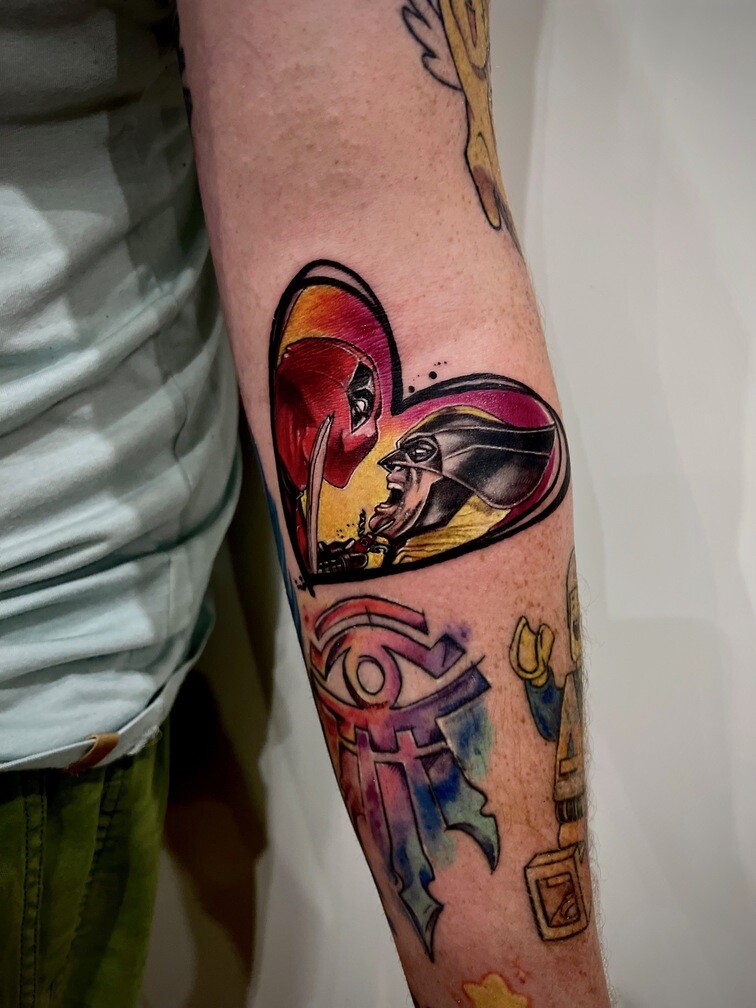
Fast forward a few years—I moved to Calgary and was a bit lost for a while, but I kept at the art. I tried some post-secondary schooling to appease my panicking parents, but I spent the entire time drawing. I put together a portfolio and started visiting studios around the city. I got almost nowhere, so life led me to Peru, of all places, where I spent four years traveling up the coast into Ecuador. I ran a shop in Mancora, where I hired artists and learned techniques by watching them.
Then in Ecuador, in a small off-grid hippie surf town called Montanita, I tattooed in my studio between two nightclubs. I worked mornings, surfed in the afternoons, and tattooed in the clubs in the evenings. Keep in mind, there weren’t a lot of rules around tattooing in South America at the time. Later, I returned to Canada and was lucky to find a very community-focused shop, The Burly Beard, that took me in and helped me grow as an artist.
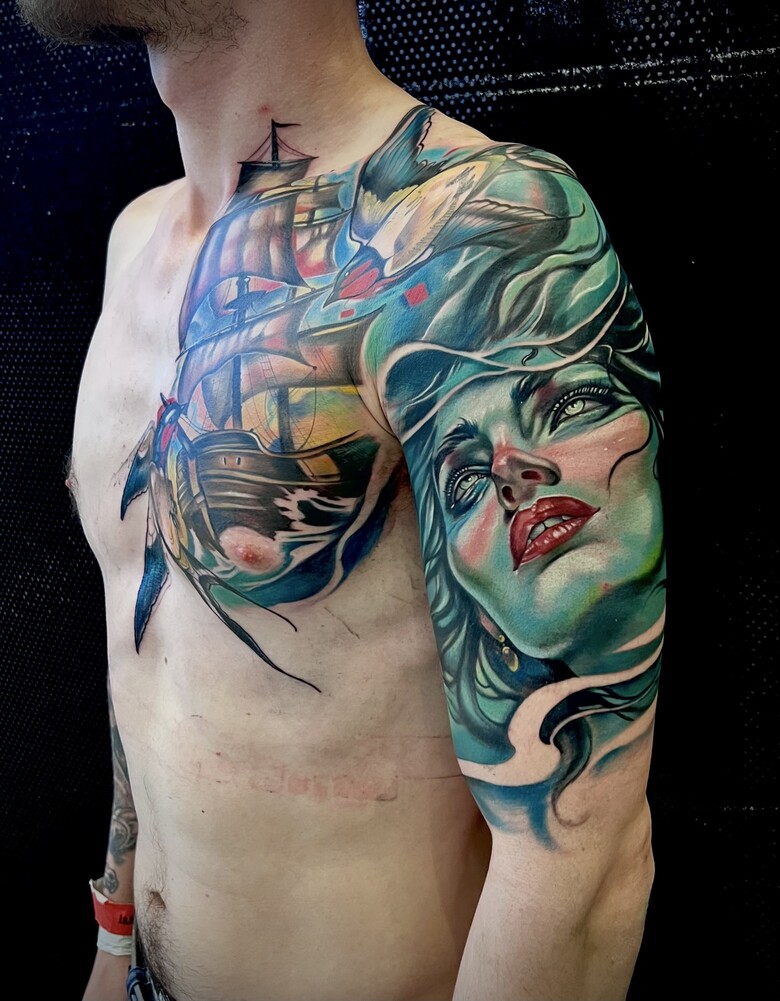
—How would you describe your artistic style?
— It has been a lot of things, but at the core, it's realism. There are a lot of influences: new school, American traditional, surrealism, watercolor, portraiture, and bold color.
I ate up new school styles and illustrative in my younger years, really found inspiration in the works of Joe Capobianco, Jime Litwalk, Victor Chil, and Theresa Sharpe
I also loved American traditional—Ed Hardy, anyone from the Smith Street crew. Influential painters like Boris Vallejo, Greg Simkins, Jenny Saville, Rembrandt, Frans Floris, and Peter Bruegel have always inspired me.
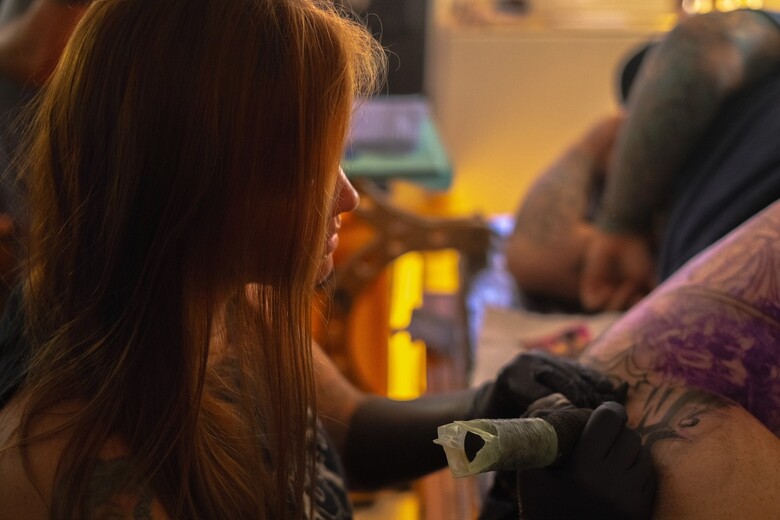
—You've been working in the industry for over 20 years. What changes in tattoo culture have you noticed during this time?
— Oh the works! This industry has transcended from a niche underground practice into a celebrated art form. We are, despite the current economic backlash of Covid, in the renaissance of the tattoo industry. It will all come full circle again, we are just in a rut at the moment overall.
It will all come full circle again; we’re just in a rut at the moment.
There have been significant advancements in machines, sterilization techniques and overall health standards, everyone was really raw doggin’ it in the 90’s… There is a lot more attention given to public health nowadays.
Likewise with machines, I operated on some pretty rough coils when I started out, and although some are very loyal to their coils, I am incredibly thankful for the advances. Coil machines, of course, will never stop being cool, or relevant. Those machines have souls. They will always hold a special place in my heart as I caught the tail end of coil culture in the industry, before making the leap to rotary/ pen machines.
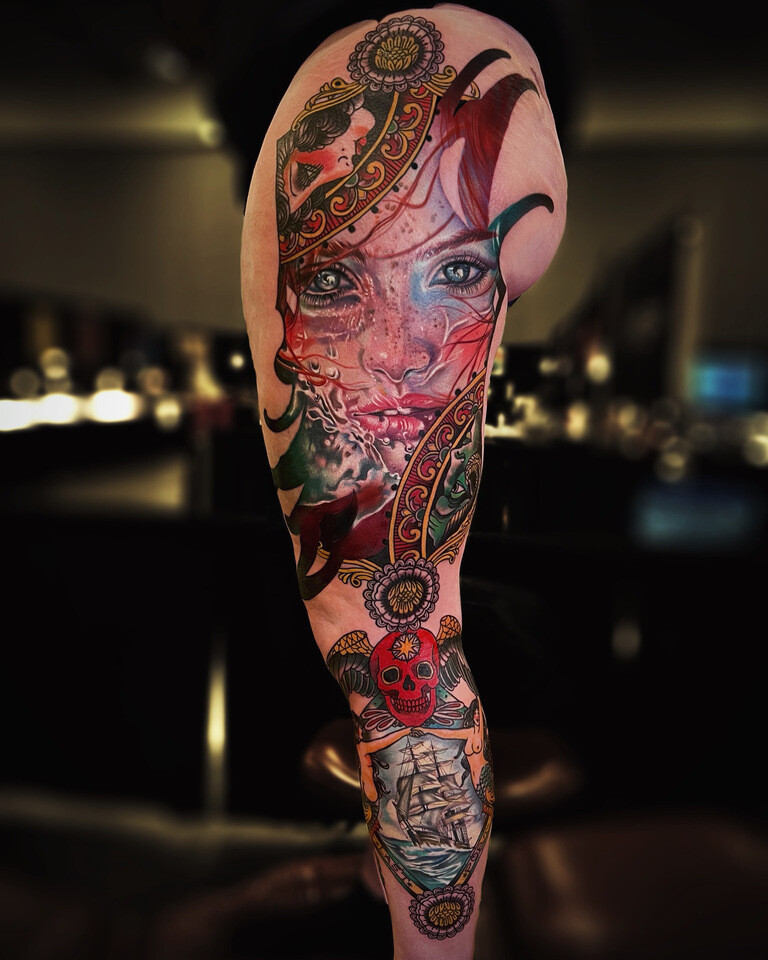
—Are there any achievements or awards that you are particularly proud of?
— I got a taste for shows and competitions in 2017 at my first show in Alberta—the Windy City Tattoo Show. I immediately felt at home among incredible artists. I was ready to work hard and build a name. I've won quite a few awards across Canada and am proud of each one. I’m also deeply grateful for every client who supported me along the way.
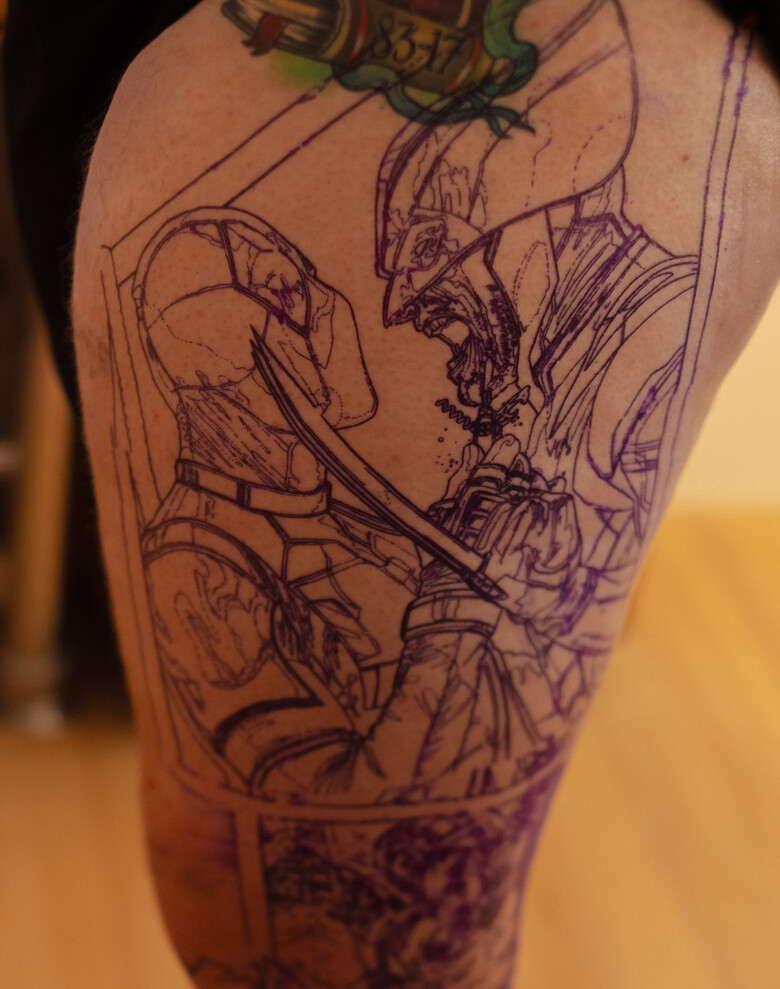
I love winning—who doesn’t? But goals evolve. As soon as you reach one, another appears just out of reach. I visualized this dream for years.
My dad spent a long time as captain of a commercial fishing vessel, and I loved hearing his harrowing tales through my youth. He has done a lot in life, including navigating 40 foot waves in the eyes of storms on the freezing cold North Pacific, and this runs in the family.
If I can continue my family’s incredible legacy, bring together community, family, and friends, and give back to the tattoo world in a powerful way—I can’t think of anything better. This is the beginning of my greatest achievement, and I’m already proud.
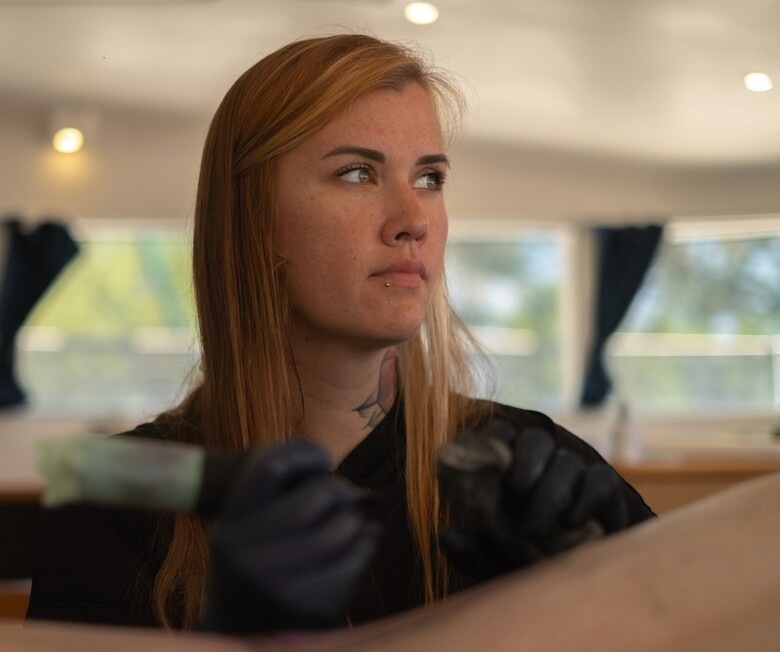
— What motivated you to leave the studio and embark on this adventure?
— A lingering search for something more, insatiable curiosity—and COVID pushed it into action. I wondered how I could keep tattooing if everything was shut down. I’m a bit old-school and see this industry as a way for artists to "stick it to the man."
So where was the grey area in all these regulations? Water. At first, it seemed crazy.
Some thought I was crazy, more thought it was brilliant.
Their feedback gave me confidence. The more I thought about it, the more it felt like a sustainable, rewarding lifestyle and business model.
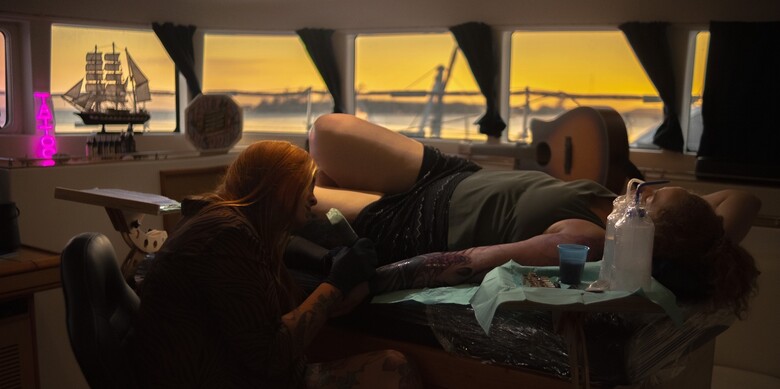
I haven’t left my studio completely. I spend six months a year on the catamaran and six months at home in Sylvan Lake with my regular clients and fellow artists. I love my Alberta community too much to cut ties completely. So, I saved every penny I could and bought a yacht—a sailing yacht, for fuel economy. Motor yachts are a fortune to run, and yachting is a rich man’s hobby.
My husband and I travelled to Corpus Christi, Texas to purchase this boat. It’s big. As big as you can sail without needing a crew onboard. Enough for a large group of people to live on independently, off grid, comfortable, if they wanted to.
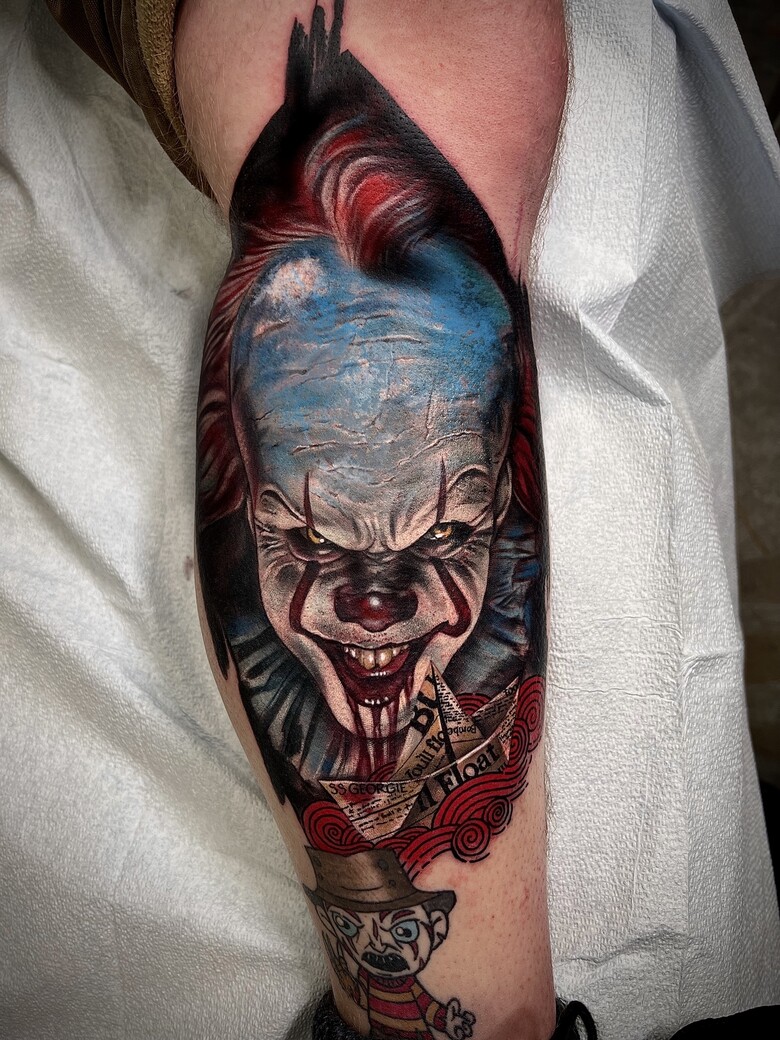
— What were your biggest fears or doubts before starting this journey?
— Everything. The amount of work that goes into all of this made me cringe initially. The unfamiliarity of some skill sets… my husband and I set out to do our ASA (American Sailing Association) certification programs for navigation, sailing vessels up to 50 feet, and specifically catamarans in moderate to heavy weather. But fears on this journey were only that.
I’ve faced some crazy and unexpected hurdles. I learned that sea sickness inevitably gets everyone at some point on the ocean. This happened during my open water dive certification while grappling with the fear of descent underwater to practice safety procedures for the first time. I felt fear in the midst of my sailing certs on a broken rib from bailing off the stern of my instructors catamaran while off shore. But I finished the course with a 96.
Failed engines in storms, and having to crawl into engine bays to flush lines while the boat is heaving in 2 meter waves.
I learned fear is just a feeling. You can choose how to respond… Some of the best things in life are found on the other side of fear.
It has tested us mentally, physically and emotionally in ways you would not believe. But we adapt. We are tough as nails, and always find a way to bounce back. I didn’t make this decision lightly, and there is a lot of suck that you have to take with the good. But the good stuff is so worth it.
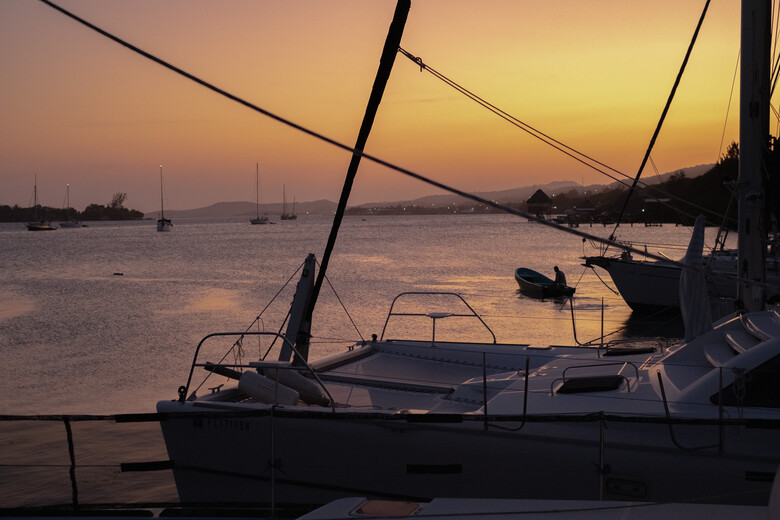
— What did the process of preparing the catamaran for a tattoo studio and comfortable living on the water look like?
— Much of the work was done DIY while the boat was hauled out on the hard, requiring long days in the heat and plenty of problem-solving.
The process began with structural work, including fiberglass repairs to reinforce the hull, replacing the standing rigging for safety and performance, and installing a new mainsail and Genoa to ensure the vessel was seaworthy and efficient under sail. Stanchions were carefully resealed to prevent leaks, and woodwork throughout the boat was sanded, refinished, and protected against the harsh marine environment.
The electrical system underwent a full rewire to support both living needs and the demands of a professional tattoo studio. Engine and sail drive repairs were completed to guarantee reliable propulsion, and outdated built-in units and furniture were removed to make space for a custom tattoo workspace.
The transformation balanced functionality with comfort, turning the catamaran into a self-sufficient floating studio and home, ready for both adventure and artistry.
The chosen space was optimized for stability, ventilation, and efficient workflow while ensuring easy access to supplies and equipment.
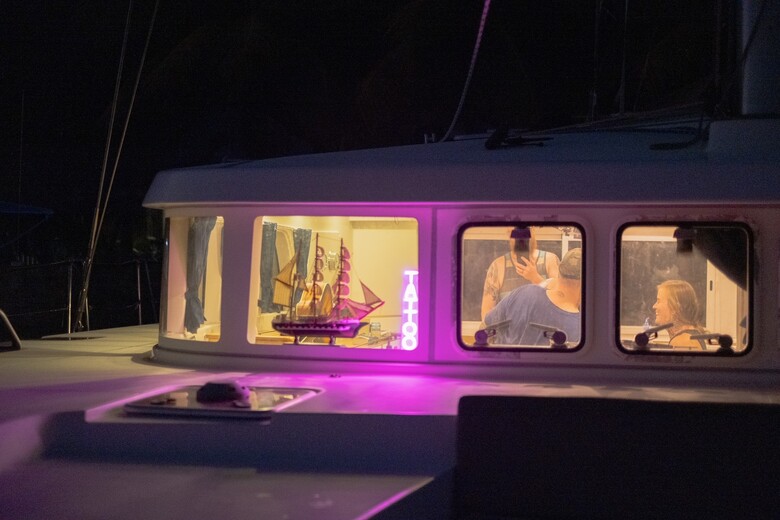
— What technical considerations did you have to take into account when working with equipment on the catamaran?
— Space, hygiene, and structural integrity. Boats are curved, which makes building harder. All systems need to remain accessible.
You need a balance between a functional studio and a resale-friendly setup. The boat’s size also affects movement at anchor, which impacts tattooing. Tattoo sessions must happen in calm waters, ideally after excursions—sailing, diving—to minimize risks related to wounds and water exposure. Humidity and salt accelerate corrosion. Equipment and supplies must be stored in airtight containers.
Licensing depends on the country, state, or province. And internet is essential. Starlink and solar panels keep us connected, power our equipment, and help us stay in touch with clients.
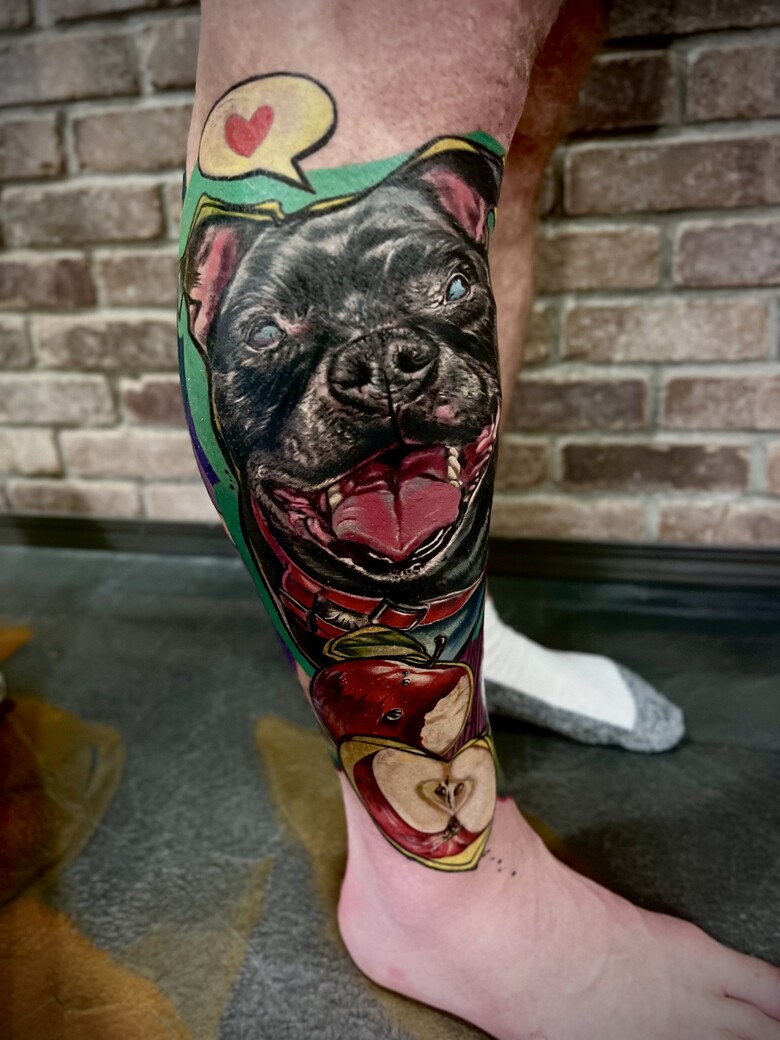
— How have your travels influenced your creativity and choice of tattoo designs?
— Every place I encounter leaves an imprint on my soul. Each place has unique symbology through culture and nature. My location heavily impacts my style. The different types of people I encounter along the way keep everything fresh, new and engaging.
It always seems to swing back to art and sailing though. I’ve fallen in love with the nod to traditional tattoo style I can juxtapose with realism. It allows me to really push my own artistic limit, and still maintain and respect the roots where this whole movement came from in the first place.
Tattoos are like waves. There are ups and downs, beauty, ugliness. Lessons and blessings. Both things mirror humanity, and a collective walk of life. Art finishes natures unrealized ends.
— What are the expectations or requirements of clients who get tattoos aboard your catamaran?
— Similar to a regular studio, but with added boat safety protocols. I assess clients’ experience with water and safety. As skipper, I’m responsible for everyone on board and for hygiene and first aid.
Tattoos are done at anchor or docked. The boat is equipped with safety and medical supplies. My husband handles diving safety and gives full briefings. We’re both certified in first aid and licensed to captain vessels in heavy weather.
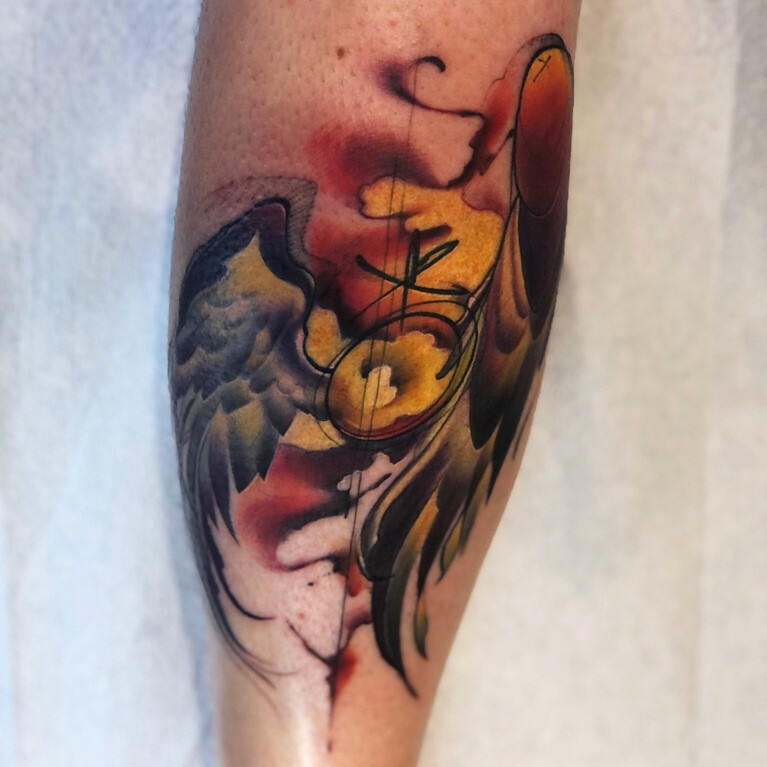
— What kind of feedback do you receive from clients about this unusual way of working?
— They never forget the experience. For a lot of folks, water is such a mysterious, unusual exotic lifestyle. I think people take some very special memories and experiences from it, and we love hosting. People come away inspired, and questioning what the confines of life actually are. How nature intertwines with the human experience.
— What do the sea, freedom, and the art of tattooing symbolize for you? How does this shape your worldview?
— Tattooing parallels the same principles of sailing. It’s about trust, inspiration, orchestration of design, and the merging of different visions and experiences on the same journey. It brings together old traditions with new fronts. Even the structure of a sailing vessel mirrors that of a tattoo machine.

Tattoo might have evolved into a celebrated art form, but we artists should never forget our roots. A counter culture in pursuit of freedom. Tattooing should be unbridled and free flowing in its nature. We shouldn’t ever forget that.
— What advice would you give to other artists who want to step outside the traditional studio format and explore new paths in the industry?
— Some of the best things in life are on the other side of fear. Take the leap of faith, don’t be scared to step out into the world. After all the hardship and crazy ups and downs of this whole shenanigan, we are currently located off the coast of Utila, anchored over a coral reef. The water is crystal clear and so beautiful. You can see right to the bottom, and it’s full of huge and wonderful fish.
This morning I woke up, swam with friendly remoras and barracuda under the hulls of our big cat. Then hopped out and made some coffee and breakfast and hung out homeschooling my boys for the morning. We are anchored here for a week, and have a couple of board travelling with us for the next couple days. I get to tattoo the port captain here in Utila. We then plan to make our way over to Roatan for diving, and tattooing tourists that run through UDC and PADI. After that, we set sail to do a crossing through the Caribbean to Curacao and the ABC islands. We will slowly make our way through the Bahamas north again to explore the Southern states.
I’m excited to discover more magic on our journeys, and meet amazing folks from all walks of life, and for the adventurous of heart, take them along with us for some of this journey of ours.

Liz’s journey is more than just a story of a tattoo artist breaking out of the traditional studio format. It’s a true manifesto of freedom and staying true to oneself—a call to dream big and bring your ideas to life, no matter how impossible they may seem from the outside. Liz has proven that art, a passion for travel, and an inner drive can transform even a catamaran in the open sea into a place of strength, creativity, and connection with kindred spirits.


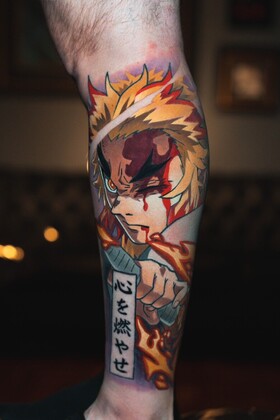
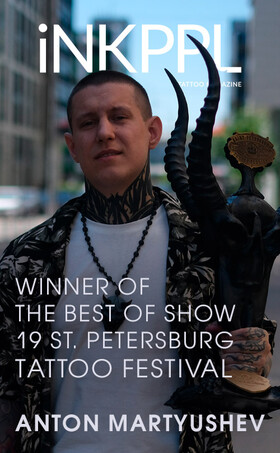

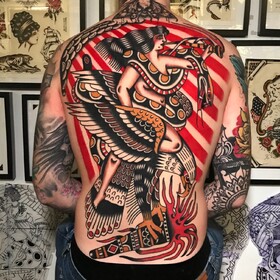

Comments (0)